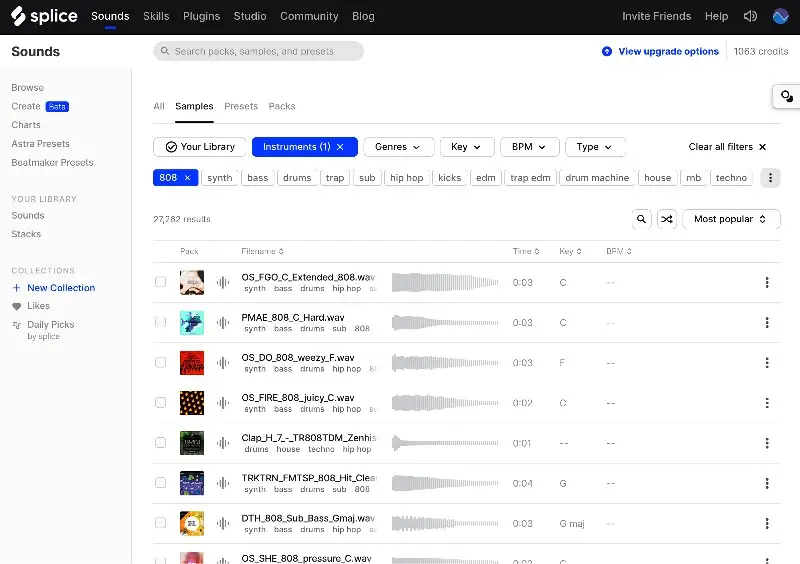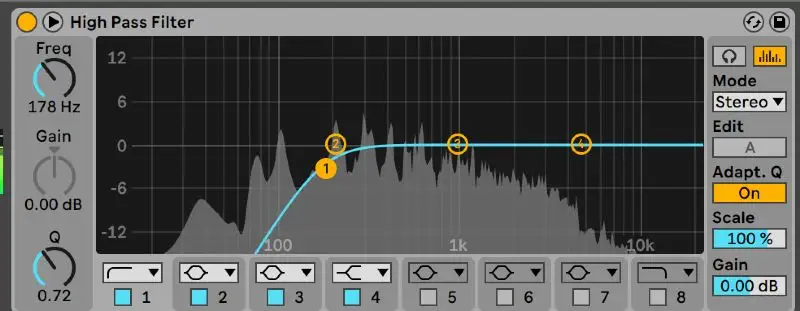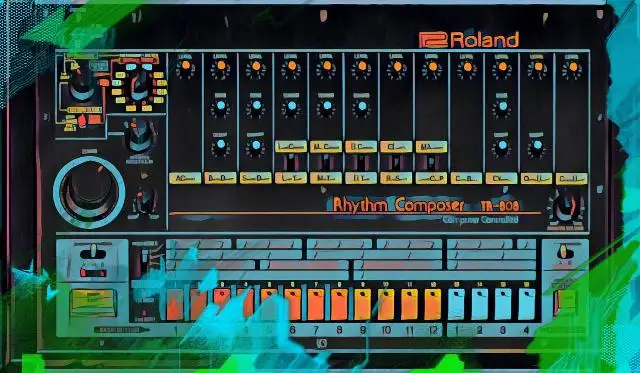Within the realm of music, like in any other domain, there exist significant moments and things that serve as milestones or icons, signifying a distinct shift in music history and altering its trajectory.
In rock and roll, the iconic Fender Stratocaster left an indelible mark on the course of musical evolution.
In the same way, the 808 drum machine played a pivotal role in shaping various genres, such as hip-hop, EDM, and modern electronic pop.
Although the initial reception of the original Roland drum machine was slow, its impact on the music industry was nothing short of revolutionary.
If you have an appreciation for the captivating 808, exploring the process behind its creation can serve as a fantastic catalyst for igniting your own creative journey.
In this guide we will thoroughly dissect the essence of classic 808 beats and provide a comprehensive guide on how to replicate them.
So without further ado, let's dive in!
What Is an 808?
The distinct drum sounds, which we refer to as 808s today, originated from the Roland TR-808 drum machine. When you're digging for samples and come across labels such as "808 kick" or "808 hats," they directly allude to the sounds produced by the TR-808.
Although the 808 drum sounds were originally born out of this old analog machine, they can now be reproduced through samples and various other drum machines. The process of recreating classic 808 beats and crafting new ones has become significantly more accessible and straightforward compared to what it was.
Despite the widespread presence of 808 beats in popular music today, it may come as a surprise that the TR-808 faced commercial failure upon its initial release in the early 80s.
However, as the decade progressed, it swiftly emerged as a seminal instrument that helped shape the identity of hip-hop, EDM, and more.
Rather than relying on samples, the original TR-808 produced its unique sound using analog synthesis. And while this pioneering instrument enabled musicians to create complete percussion tracks from start to finish, most people particularly cherish the 808 for its deep and resonant bass drum sound.
Furthermore, this drum machine served as a precursor to subsequent consoles and other modern drum machines, including the 909, and continues to be cherished by producers who hold a strong affinity for vintage sounds.
Examples of 808s in Popular Music
Marvin Gaye - "Sexual Healing"
Marvin Gaye's "Sexual Healing" is a classic example of the 808 drum machine's impact on popular music. Released in 1982, the song showcased the distinctive sound and groove that the 808 brought to the table.
In fact, the song opens with the 808 kick drum and provides a strong and steady pulse throughout the song.
Afrika Bambaataa & The Soulsonic Force - "Planet Rock"
Afrika Bambaataa & The Soulsonic Force's "Planet Rock" was one of the most groundbreaking tracks of the 80s and is often considered a pivotal shift in the evolution of hip-hop and electronic music.
And as you might have guessed, it heavily features the 808 drum machine.
Released in 1982, this hybrid dance music track fused elements of hip-hop and electro, and its innovative use of the 808 helped define its futuristic sound. The track opens with a now-iconic 808 cowbell pattern, all with its distinctive metallic and percussive sound.
You can also hear the 808 snare in "Planet Rock," with its sharp, snappy quality.
Beastie Boys - "Paul Revere"
"Paul Revere" is a classic track off the 1986 Beastie debut album, "Licensed to Ill."
The track prominently features the Roland TR-808 drum machine, opening up with the iconic drum break, which features a number of 808 elements, including the booming bass drum, the crispy snare, analog handclaps, and a few other percussion elements.
Kanye West - "Love Lockdown"
"Love Lockdown" came off of Kanye West's iconic "808s & Heartbreak" album. If the album name didn't make it clear enough, it's known for its heavy use of the Roland TR-808 drum machine.
The thing that's unique about the 808 bass drum in "Love Lockdown" is that it incorporates a far longer decay than the other songs, creating a sustained bass sound.
It's most likely what you're used to hearing in modern hip-hop production.
Destiny's Child - "Say My Name"
The 808 drum machine subtly weaves its magic into this remarkable '90s track. Amidst the multiple layers of this popular hit, the 808 plays a pivotal role in its success. Think about the countless times you've heard the unforgettable phrase, "Say my name!" sung by Beyoncé and Destiny's Child. Well, the credit for that infectious hook goes to the powerful combination of this trio and the 808.
How to Make an 808 Beat
It's highly likely that you're already incorporating deep sub-bass samples into your music, as it has become an integral part of contemporary production. The versatility of 808 sub-bass allows you to accentuate kick hits and drops or even tune it to generate impactful melodic bass lines.
With a vast array of 808 samples available, you have access to a multitude of options, many of which have been creatively processed to offer distinct sounds suitable for various genres and musical styles.
Choose the Right Sample

Selecting the right samples is a crucial aspect of creating a remarkable beat.
It's essential to take the context into account.
If you already have an instrumental loop or chord progression in place, begin exploring 808 samples that harmonize well with the other elements. There are numerous options available, especially on sample platforms like Loopmasters or Splice, which offer vast libraries of these samples for you to experiment with.
Keep It In Tune
An unmistakable sign of newbie production is an 808 that isn't tuned correctly.
Pre-tuned samples are designed to match a specific pitch, and if they don't align with the key of the song, they won't sound right.
Tuning a sample can be approached in various ways, but one of the most popular methods involves using a sampler that allows you to play the sample across different notes on a keyboard.
This not only enables you to adjust the pitch but also opens up possibilities for creating unique patterns.
Carve Out Frequencies

808s primarily occupy the sub-bass range, with fundamental frequencies typically ranging from around 20 to 60 Hz.
When you're working with sub-samples, it's important to apply EQ techniques that enhance their deep, powerful low-end.
However, it's easy for a mix to become muddy when there are too many low-end elements, and conflicts can arise when you have an 808 that clashes with a synth bass or kick drum, if present.
When you EQ your low-end instruments, the key is to assign specific roles to each element to create a sonic space for each.
I recommend allowing the 808 to dominate the lowest frequencies while applying filtering to the kick drum or bass to avoid frequency clashes and ensure it delivers punchiness without excessive sub by low-end information.
Utilizing ADSR
By adjusting the envelope controls found on your sampler, you can manipulate the attack time of your 808 samples.
There are many benefits to changing up the ADSR parameters on your 808.
For example, when you increase the attack time, it introduces a delay before the sub reaches its peak level.
This creates a unique sonic effect where the punch or initial transient of the kick is heard first, followed by a quick build of the sub frequencies.
Conversely, many producers aim for a harder-hitting sub with a faster attack to enhance the impact of the kick.
I highly recommend experimenting with the decay, sustain, and release parameters, too, as they can help you find the ideal envelope that complements the track's overall sound.
Playing around with these settings allows you to fine-tune the sub sample's characteristics and tailor it to fit perfectly within your composition.
Understand Your Playback System
It's important to consider that many consumer-grade playback devices don't reproduce ultra-low sub-frequencies that you hear when mixing on pro-quality headphones or monitors.
To ensure that your 808 is audible on a range of playback devices, you might have to use saturation or boost some fundamental frequency overtones.
Once you have determined what key your music is in, you can refer to a frequency chart to get a better idea of the notes and where they lie throughout the octave range. You'll also be able to see overtones with a frequency analyzer.
This will help you identify a frequency that has a better chance of being heard on other systems. By making strategic frequency adjustments, you can optimize the listening experience of your 808 across different platforms.
808s for Life
The presence of 808 is ubiquitous in various genres, particularly in trap, hip-hop, and similarly impactful styles. By employing these 808 techniques in your tracks and studying the 808s found on iconic tracks of the past, you can create a commanding 808 beat to pay tribute to one of history's most iconic drum machines.





